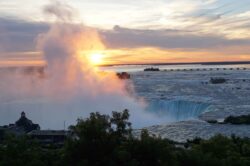Fresh Air: Plein Air Painting with Tusc & Pine

[SPONSORED CONTENT]
It’s spring in Colorado, and as the snow melts and the air warms, the Rocky Mountains become a prime location for plein air painting. And as I consider the fresh mountain air crystal waters, it seems appropriate to embrace a fresh palette, which is exactly how I approached a recent sunrise painting session in Rocky Mountain National Park, bringing with me a fresh set of Tusc & Pine Artists’ Oil Paints.


Gathering Supplies
Tusc & Pine Artists’ Oil Paints are described as being made with a combination of traditional methods and modern technology, which suggested they would handle in a specific way. I was interested to evaluate this on location. The goal for this painting session was a focused study: to discover a location, observe the light, gather visual information on color and texture, and note how this all could inform a larger studio piece. This means, the paint I’m using needs to provide rich, accurate color and perform well at various viscosities, from thin washes, to thick, textured brushwork.

For a true test, I paired my selection of paints with Tusc & Pine solvent and alkali refined linseed oil medium. As a professional-grade paint, I felt it best to pair these paints with Centurion linen panels (specially made for oil painting) and a selection of Hamburg and Imperial brushes.


Materials
The materials featured in this article can all be purchased at Jerry’s Artarama.
Getting Started
Sunrise in the mountains was beautiful, but cold. After scouting several locations, I set up by a bend in a high mountain stream. While less dramatic than the towering peaks in the park, I found the quiet intimacy and the textures of the location compelling. Considering the potential for a future studio painting, I found the symbolism of these headwaters that would eventually find their way to the distant Atlantic Ocean compelling.
Plein air painting is an act of discovery. I’m experiencing the landscape and, through painting, searching for potential in a finished painting. Sometimes, a plein air painting is a complete work in itself. Other times, like this one, I’m recording an experience that could inform a painting to be completed in the studio. For a study like this, I need to push my materials to perform in a variety of ways as I search for the visual language that best describes my experience.

In the case of this painting, the richness of the color and the versatility of the paints is making for an exceptionally enjoyable experience. My initial layers cover well when thinned with solvent. As I build layers of thicker, more viscous paint, they float nicely on top of one another, and I can work wet edges together as the painting develops. Discovering the color takes some time, so I find myself remixing, scraping, and layering color. The pigment strength of the Tusc & Pine paints makes this happen easily.
The streamside grasses, with their complex textures, presented an opportunity to explore drybrush techniques. Here, the interaction of the paints with my brushes became an important factor. The paint’s ability to maintain a defined brushstroke allowed the stiffer Imperial bristle brushes to be effective tools for creating texture. The paint could be loaded and manipulated—scraped, scumbled, pushed, and dragged—to describe the character of the vegetation on the linen. The softer Hamburg brushes offered control for blending and smooth application in water as I explore the blues of the sky’s reflection and the neutral colors in transparent areas of the stream where rocks are visible.

Peak Performance
Ultimately, the success of a plein air study lies in its ability to capture the essence of an experience and provide a rich source of information for future work. To truly push the boundaries of your observation and translate the nuances of light, color, and texture onto your surface, the quality of your materials is critical. Just as embracing a fresh palette felt appropriate for the crisp spring air, ensuring your paints can truly perform allows you to fully capture that fresh experience.
Paints that offer exceptional pigment strength and versatile handling allow you to explore thin glazes, build impasto, execute precise drybrush strokes, and blend seamlessly—essential techniques for gathering visual notes on location. Investing in professional-grade paints and complementary mediums gives you the freedom to fully explore the potential of your subject matter, providing a wider range of controlled, vibrant colors and application methods. These studies, born from direct experience and rendered with materials that perform under pressure, become invaluable assets, offering a wealth of visual options and technical insights to draw upon when you return to the studio to create larger, more developed works. Don’t compromise on the tools that help you see, record and, ultimately, create.

Meet the Artist
Scott Maier is an artist, instructor, and a content contributor to artistsnetwork.com. He’s an adjunct instructor at Rocky Mountain College of Art and Design, as well as the author of the instructional art book See, Think, Draw: An Easy Guide for Realistic Drawing and Beyond.
 Artists Network Membership - 1 Month
Artists Network Membership - 1 Month  Breakthrough Paint Along: Where Mixed Media Combine Together
Breakthrough Paint Along: Where Mixed Media Combine Together  Paint Along 127: Paint the Motion of the Sea
Paint Along 127: Paint the Motion of the Sea  Paint Along 126: Simplify Your Landscapes with a Limited Palette
Paint Along 126: Simplify Your Landscapes with a Limited Palette 















Join the Conversation!